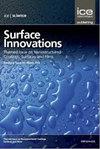Pulsed plasma polymerisation of carvone: characterisations and antibacterial properties
IF 3.5
4区 材料科学
Q3 CHEMISTRY, PHYSICAL
引用次数: 4
Abstract
The production of suitable coatings with excellent antibacterial performance has now become a viable technique for enhancing the functional qualities of various biomedical materials. Here, pulsed plasma polymerisation was used to produce an antibacterial coating from the carvone oil of the spearmint plant. The coating films have adjustable chemical and physical properties based on the deposition parameter – that is, duty cycle (DC). The static water contact angle (WCA) values of pulsed wave (PW) plasma-polymerised carvone (ppCar) increase with the increase in DC. Fourier transform infrared spectroscopy and X-ray photoelectron spectroscopy showed that the molecular structure of carvone is less fragmented, retaining moieties associated with C–O and C=O when the DC is reduced. These C–O and C=O moieties likely reduced the measured static WCA. This surface chemical composition with predominantly C–O and C=O also showed a stronger bactericidal effect, based on the biofilm assay with bacteria (Escherichia coli and Staphylococcus aureus), compared with those coatings with C–C and C–H produced at a higher DC. As shown by the atomic force microscopy images, a lower DC resulted in smoother and more homogeneous coatings than those produced with a higher DC, while field emission scanning electron microscopy images show that when E. coli and S. aureus membranes were attached to PW ppCar, they ruptured and distorted with a pore created and that these distortions and ruptures increased as the DC was reduced.脉冲等离子体聚合香芹酮:特性和抗菌性能
生产具有优良抗菌性能的合适涂料已成为提高各种生物医用材料功能品质的可行技术。在这里,脉冲等离子体聚合被用于从薄荷植物的香芹酮油中生产抗菌涂层。根据沉积参数,即占空比(DC),涂层具有可调节的化学和物理性能。脉冲波(PW)等离子体聚合香芹酮(ppCar)的静态水接触角(WCA)值随DC的增加而增加。傅里叶变换红外光谱和x射线光电子能谱分析表明,香芹酮的分子结构碎片化程度较低,当DC还原时保留了与C - O和C=O相关的部分。这些C - O和C=O基团可能降低了测量的静态WCA。根据细菌(大肠杆菌和金黄色葡萄球菌)的生物膜测定,与在较高DC下产生的C - C和C - h涂层相比,这种以C - O和C=O为主的表面化学成分也显示出更强的杀菌效果。原子力显微镜图像显示,较低DC产生的涂层比较高DC产生的涂层更光滑,更均匀,而场发射扫描电镜图像显示,当大肠杆菌和金黄色葡萄球菌膜附着在PW ppCar上时,它们会破裂和扭曲,并产生一个孔,并且这些扭曲和破裂随着DC的降低而增加。
本文章由计算机程序翻译,如有差异,请以英文原文为准。
求助全文
约1分钟内获得全文
求助全文
来源期刊

Surface Innovations
CHEMISTRY, PHYSICALMATERIALS SCIENCE, COAT-MATERIALS SCIENCE, COATINGS & FILMS
CiteScore
5.80
自引率
22.90%
发文量
66
期刊介绍:
The material innovations on surfaces, combined with understanding and manipulation of physics and chemistry of functional surfaces and coatings, have exploded in the past decade at an incredibly rapid pace.
Superhydrophobicity, superhydrophlicity, self-cleaning, self-healing, anti-fouling, anti-bacterial, etc., have become important fundamental topics of surface science research community driven by curiosity of physics, chemistry, and biology of interaction phenomenon at surfaces and their enormous potential in practical applications. Materials having controlled-functionality surfaces and coatings are important to the manufacturing of new products for environmental control, liquid manipulation, nanotechnological advances, biomedical engineering, pharmacy, biotechnology, and many others, and are part of the most promising technological innovations of the twenty-first century.
 求助内容:
求助内容: 应助结果提醒方式:
应助结果提醒方式:


